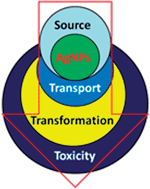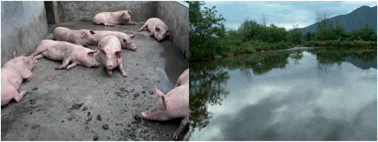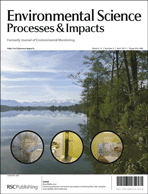This month sees the following articles in Environmental Science: Processes & Impacts that are in the top ten most accessed:-
Evaluation of a low-cost commercially available extraction device for assessing lead bioaccessibility in contaminated soils
Clay M. Nelson, Thomas M. Gilmore, James M. Harrington, Kirk G. Scheckel, Bradley W. Miller and Karen D. Bradham
Environ. Sci.: Processes Impacts, 2013, 15, 573-578
DOI: 10.1039/C2EM30789H
Size distribution effects of cadmium tellurium quantum dots (CdS/CdTe) immunotoxicity on aquatic organisms
A. Bruneau, M. Fortier, F. Gagne, C. Gagnon, P. Turcotte, A. Tayabali, T. L. Davis, M. Auffret and M. Fournier
Environ. Sci.: Processes Impacts, 2013, 15, 596-607
DOI: 10.1039/C2EM30896G
Levels and distribution of polybrominated diphenyl ethers in soil, sediment and dust samples collected from various electronic waste recycling sites within Guiyu town, southern China
Iryna Labunska, Stuart Harrad, David Santillo, Paul Johnston and Kevin Brigden
Environ. Sci.: Processes Impacts, 2013, 15, 503-511
DOI: 10.1039/C2EM30785E
The impact of marine shallow-water hydrothermal venting on arsenic and mercury accumulation by seaweeds Sargassum sinicola in Concepcion Bay, Gulf of California
María Luisa Leal-Acosta, Evgueni Shumilin, Nicolai Mirlean, Francisco Delgadillo-Hinojosa and Ignacio Sánchez-Rodríguez
Environ. Sci.: Processes Impacts, 2013, 15, 470-477
DOI: 10.1039/C2EM30866E
Monitoring the Performance and Microbial Diversity Dynamics of a Full Scale Anaerobic Wastewater Treatment Plant Treating Sugar Factory Wastewater
N. Altınay Perendeci, F. Yeşim Ekinci and Jean Jaques Godon
Environ. Sci.: Processes Impacts, 2013, 15, 494-502
DOI: 10.1039/C2EM30597F
Link fluorescence spectroscopy to diffuse soil source for dissolved humic substance in Daning River, China
Hao Chen, Bing-hui Zheng and Lei Zhang
Environ. Sci.: Processes Impacts, 2013, 15, 485-493
DOI: 10.1039/C2EM30715D
Resolving sources of water-soluble organic carbon in fine particulate matter measured at an urban site during winter
Sung Yong Cho and Seung Shik Park
Environ. Sci.: Processes Impacts, 2013, 15, 524-534
DOI: 10.1039/C2EM30730H
A Portable Analyzer for the Measurement of Ammonium in Marine Waters
Natchanon Amornthammarong, Jia-Zhong Zhang, Peter B. Ortner, Jack Stamates, Michael Shoemaker and Michael W. Kindel
Environ. Sci.: Processes Impacts, 2013, 15, 579-584
DOI: 10.1039/C2EM30793F
Uncertainty models and influence of the calibration span on ambient air measurements of NO2 by chemiluminescence
Marta Doval Miñarro, Pascual Pérez Ballesta, Jonathan Barberá Rico and Enrique González Ferradás
Environ. Sci.: Processes Impacts, 2013, 15, 512-523
DOI: 10.1039/C2EM30395G
Impact of a snail pellet on the phytoavailability of different metals to cucumber plants (Cucumis sativus L.)
Sabine Freitag, Eva M. Krupp, Andrea Raab and Jörg Feldmann
Environ. Sci.: Processes Impacts, 2013, 15, 463-469
DOI: 10.1039/C2EM30806A
Why not take a look at the articles today and blog your thoughts and comments below.
Fancy submitting an article to Environmental Science: Processes & Impacts? Then why not submit to us today or alternatively email us your suggestions.
Comments Off on Top ten most accessed Environmental Science: Processes & Impacts articles in January 2013
 This recently published article from Jing-Fu Liu et al. takes a critical view of the current investigations into the effects that silver nanoparticles have on the environment. It was published in January’s themed issue on Anthropogenic nanoparticles in the environment.
This recently published article from Jing-Fu Liu et al. takes a critical view of the current investigations into the effects that silver nanoparticles have on the environment. It was published in January’s themed issue on Anthropogenic nanoparticles in the environment. 

















